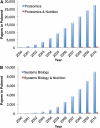Proteomics and systems biology: current and future applications in the nutritional sciences
- PMID: 22332076
- PMCID: PMC3125684
- DOI: 10.3945/an.111.000554
Proteomics and systems biology: current and future applications in the nutritional sciences
Abstract
In the last decade, advances in genomics, proteomics, and metabolomics have yielded large-scale datasets that have driven an interest in global analyses, with the objective of understanding biological systems as a whole. Systems biology integrates computational modeling and experimental biology to predict and characterize the dynamic properties of biological systems, which are viewed as complex signaling networks. Whereas the systems analysis of disease-perturbed networks holds promise for identification of drug targets for therapy, equally the identified critical network nodes may be targeted through nutritional intervention in either a preventative or therapeutic fashion. As such, in the context of the nutritional sciences, it is envisioned that systems analysis of normal and nutrient-perturbed signaling networks in combination with knowledge of underlying genetic polymorphisms will lead to a future in which the health of individuals will be improved through predictive and preventative nutrition. Although high-throughput transcriptomic microarray data were initially most readily available and amenable to systems analysis, recent technological and methodological advances in MS have contributed to a linear increase in proteomic investigations. It is now commonplace for combined proteomic technologies to generate complex, multi-faceted datasets, and these will be the keystone of future systems biology research. This review will define systems biology, outline current proteomic methodologies, highlight successful applications of proteomics in nutrition research, and discuss the challenges for future applications of systems biology approaches in the nutritional sciences.
Conflict of interest statement
Author disclosures: J. B. Moore and M. E. Weeks, no conflicts of interest.
Figures


Similar articles
-
Novel omics technologies in nutrition research.Biotechnol Adv. 2008 Mar-Apr;26(2):169-76. doi: 10.1016/j.biotechadv.2007.11.002. Epub 2007 Nov 19. Biotechnol Adv. 2008. PMID: 18164161 Review.
-
Integrative omics - from data to biology.Expert Rev Proteomics. 2018 Jun;15(6):463-466. doi: 10.1080/14789450.2018.1476143. Epub 2018 May 18. Expert Rev Proteomics. 2018. PMID: 29757692
-
Where are we in genomics?J Physiol Pharmacol. 2005 Jun;56 Suppl 3:37-70. J Physiol Pharmacol. 2005. PMID: 16077195 Review.
-
Systems biology approaches to understand the effects of nutrition and promote health.Br J Clin Pharmacol. 2017 Jan;83(1):38-45. doi: 10.1111/bcp.12965. Epub 2016 May 29. Br J Clin Pharmacol. 2017. PMID: 27062443 Free PMC article. Review.
-
Integrating 'omic' information: a bridge between genomics and systems biology.Trends Genet. 2003 Oct;19(10):551-60. doi: 10.1016/j.tig.2003.08.009. Trends Genet. 2003. PMID: 14550629 Review.
Cited by
-
Asthma, allergy, and responses to methyl donor supplements and nutrients.J Allergy Clin Immunol. 2014 May;133(5):1246-54. doi: 10.1016/j.jaci.2013.10.039. Epub 2013 Dec 19. J Allergy Clin Immunol. 2014. PMID: 24360248 Free PMC article. Review.
-
Lost in Translation (LiT): IUPHAR Review 6.Br J Pharmacol. 2014 May;171(9):2269-90. doi: 10.1111/bph.12580. Br J Pharmacol. 2014. PMID: 24428732 Free PMC article. Review.
-
Marine Lipids on Cardiovascular Diseases and Other Chronic Diseases Induced by Diet: An Insight Provided by Proteomics and Lipidomics.Mar Drugs. 2017 Aug 18;15(8):258. doi: 10.3390/md15080258. Mar Drugs. 2017. PMID: 28820493 Free PMC article. Review.
-
Development of an undergraduate bioinformatics degree program at a liberal arts college.Yale J Biol Med. 2012 Sep;85(3):309-21. Epub 2012 Sep 25. Yale J Biol Med. 2012. PMID: 23012579 Free PMC article.
-
Molecular nutrition research: the modern way of performing nutritional science.Nutrients. 2012 Dec 3;4(12):1898-944. doi: 10.3390/nu4121898. Nutrients. 2012. PMID: 23208524 Free PMC article. Review.
References
Publication types
MeSH terms
LinkOut - more resources
Full Text Sources
Research Materials

